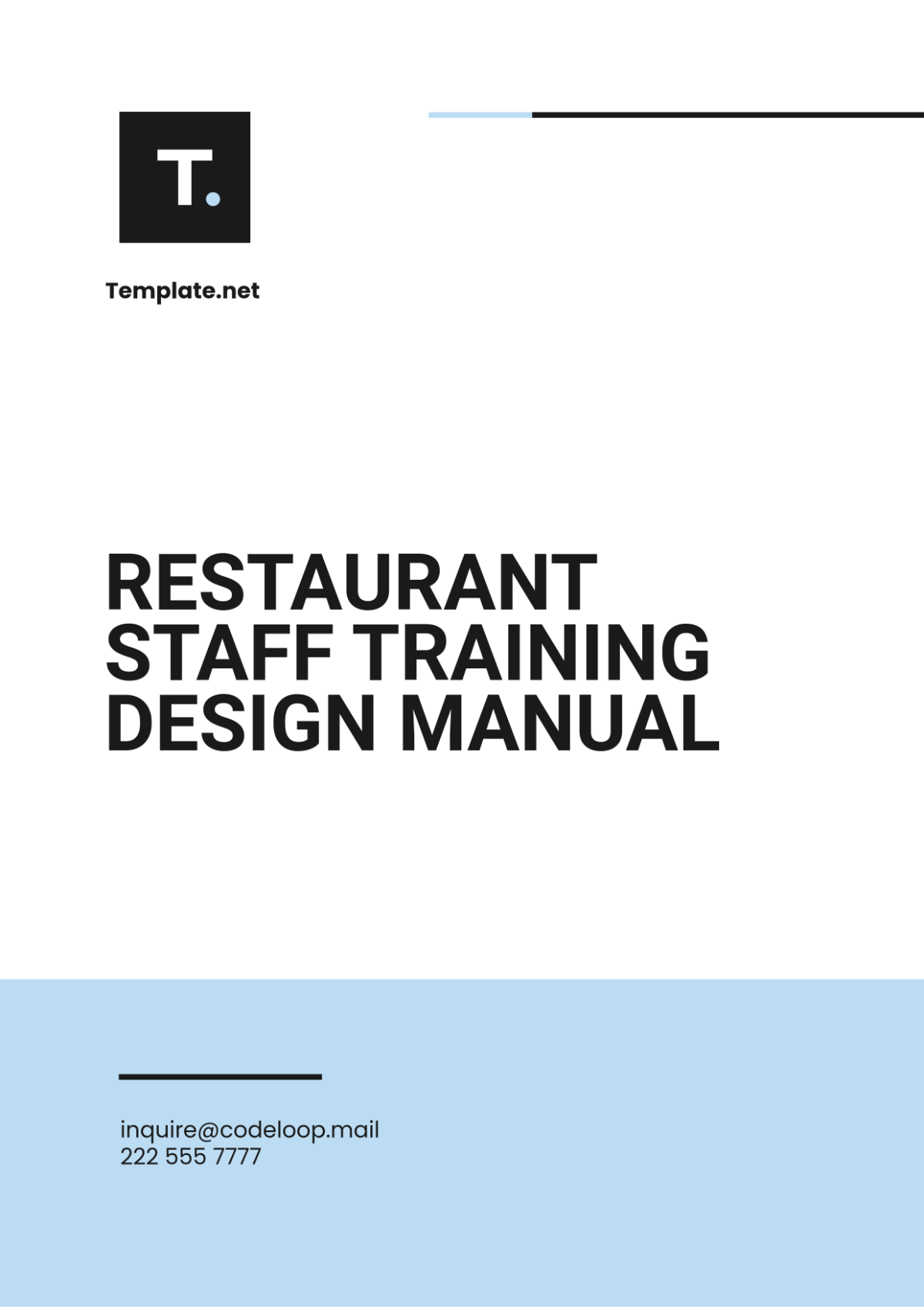Free Restaurant Staff Training Design Manual

Prepared By: | [YOUR NAME] |
Company: | [YOUR COMPANY NAME] |
Department: | [YOUR DEPARTMENT] |
Date: | [DATE] |
I. Introduction
The purpose of this Restaurant Staff Training Design Manual is to provide clear guidelines and structured training programs to ensure that all restaurant staff members are well-equipped to deliver exceptional service. The manual outlines the responsibilities of each position, operational procedures, and the training process, to maintain consistent quality, safety, and customer satisfaction.
This manual serves as a reference guide for employees at all levels, from new hires to experienced staff, helping them understand their roles, improve their skills, and stay aligned with the restaurant’s standards.
II. Organizational Structure
Understanding the organizational hierarchy is crucial for smooth operations. The typical structure of our restaurant includes:
General Manager (GM): Oversees overall restaurant operations, and financial management, and ensures compliance with regulations.
Assistant Manager: Supports the GM in day-to-day operations, staff scheduling, and customer service.
Head Chef/Kitchen Manager: Manages the kitchen team, oversees food preparation, and ensures quality control.
Servers: Responsible for customer service, taking orders, and ensuring guests have a pleasant dining experience.
Kitchen Staff: Prepares food items according to the menu, maintains hygiene standards, and ensures timely service.
Bartender (if applicable): Prepares beverages, maintains inventory, and ensures customer satisfaction at the bar.
Host/Hostess: Greets customers, manages reservations, and ensures efficient seating arrangements.
Each role is interconnected, requiring teamwork and clear communication for successful daily operations.
III. Training Objectives
The training program aims to:
Provide employees with the knowledge and skills necessary to perform their duties effectively.
Ensure that all staff members are aware of the restaurant's standards, policies, and procedures.
Foster a culture of continuous learning, professional growth, and teamwork.
Enhance customer satisfaction through consistent service excellence and food quality.
Minimize mistakes, reduce waste, and ensure compliance with health and safety regulations.
IV. Job Descriptions
General Manager (GM):
Oversees all restaurant operations, including hiring, budgeting, and ensuring compliance with restaurant policies.
Ensures customer satisfaction and problem resolution.
Assistant Manager:
Assists in staff management, scheduling, and overseeing service quality.
Manages day-to-day operational issues in the absence of the GM.
Head Chef/Kitchen Manager:
Manages the kitchen, creates menus, and ensures food is prepared according to standards.
Oversees kitchen staff and maintains hygiene protocols.
Servers:
Takes orders, serves food, and ensures guests have a satisfactory dining experience.
Manages payments and handles any customer concerns.
Kitchen Staff:
Prepares food as per recipes and quality standards.
Maintains cleanliness and organization in the kitchen.
Bartender (if applicable):
Prepares and serves drinks to customers in the bar area.
Maintains stock and ensures the bar area is clean and organized.
Host/Hostess:
Greets customers manages reservations and oversees seating arrangements.
V. Standard Operating Procedures (SOPs)
A. Customer Service SOP
Greet guests within 30 seconds of arrival.
Present menus, take orders, and ensure timely service of food and beverages.
Handle complaints and feedback professionally and resolve issues promptly.
B. Food Preparation SOP
Follow all recipes and portion control guidelines.
Ensure food is cooked to the correct temperature and presented as per restaurant standards.
Adhere to food safety and hygiene regulations.
C. Health and Safety SOP
Wash hands regularly and wear appropriate protective clothing (e.g., aprons, gloves).
Use and store equipment safely and report any hazards.
Ensure compliance with local health and safety regulations.
D. Cleaning and Sanitization SOP
Clean tables, counters, and kitchen surfaces after every use.
Ensure all utensils and equipment are properly sanitized after each use.
Regularly check and clean restrooms and customer areas.
VI. Training Modules
Module 1: Introduction to the Restaurant
Overview of the restaurant's mission, values, and goals.
Introduction to key staff and orientation of the work environment.
Module 2: Customer Service Training
Effective communication with customers.
Handling complaints and difficult customers.
Understanding the menu and making recommendations.
Module 3: Food Safety and Hygiene
Importance of food hygiene.
Procedures for washing hands, wearing protective gear, and preventing contamination.
Safe handling of food and cleaning procedures.
Module 4: Job-Specific Training
For Servers: Taking orders, managing payments, and customer interaction.
For Kitchen Staff: Food preparation, cooking techniques, and kitchen safety.
For Bartenders: Drink mixing, serving customers, and maintaining stock.
For Hosts/Hostesses: Reservation management and seating arrangements.
Module 5: Teamwork and Communication
Importance of clear communication between the kitchen and front-of-house staff.
Techniques for fostering collaboration and supporting team members.
VII. Assessment and Evaluation
To ensure the effectiveness of the training, regular assessments will be conducted:
A. New Hire Evaluation
Performance will be evaluated at the end of the training period.
Trainers and supervisors will assess knowledge retention, task performance, and adherence to SOPs.
B. Ongoing Assessments
Periodic performance reviews will be held to assess long-term performance, including customer feedback, task efficiency, and teamwork.
Regular refreshers or additional training may be provided if needed.
C. Feedback Mechanism
Employees will have the opportunity to give feedback on the training process to help improve future programs.
VIII. Resources
The following resources are available for further training and support:
Employee Handbook: A comprehensive guide to restaurant policies and procedures.
Training Videos: Visual demonstrations of SOPs, customer service, and safety protocols.
Mentorship Program: Senior staff members will be assigned as mentors to guide new employees through their first weeks on the job.
External Training Courses: Opportunities for advanced training in food safety, customer service, and leadership through accredited programs
- 100% Customizable, free editor
- Access 1 Million+ Templates, photo’s & graphics
- Download or share as a template
- Click and replace photos, graphics, text, backgrounds
- Resize, crop, AI write & more
- Access advanced editor
Enhance your restaurant's performance with Template.net's Restaurant Staff Training Design Manual Template. This fully editable and customizable template helps you design training materials that cover customer service, food preparation, and health standards. Editable in our Ai Editor Tool, you can easily modify the manual to fit your restaurant's specific operations, ensuring that your staff is well-prepared to provide exceptional service.





























